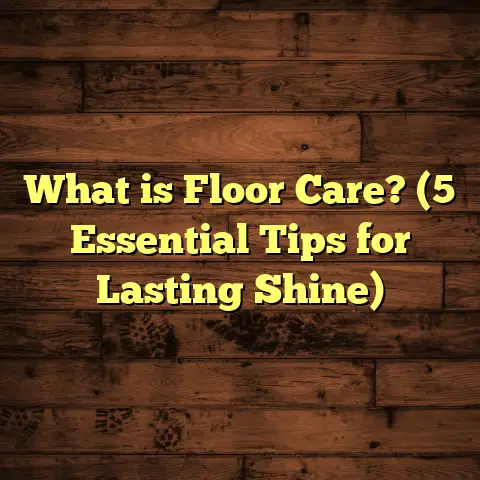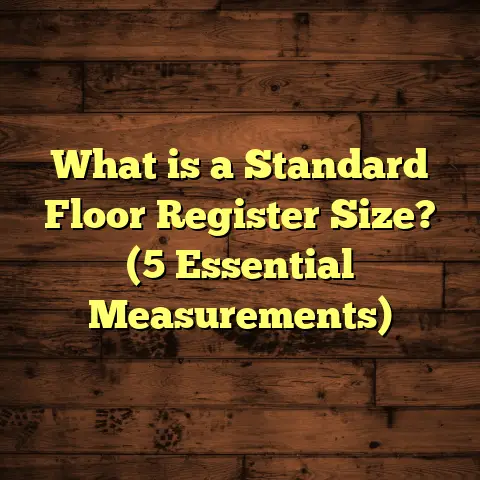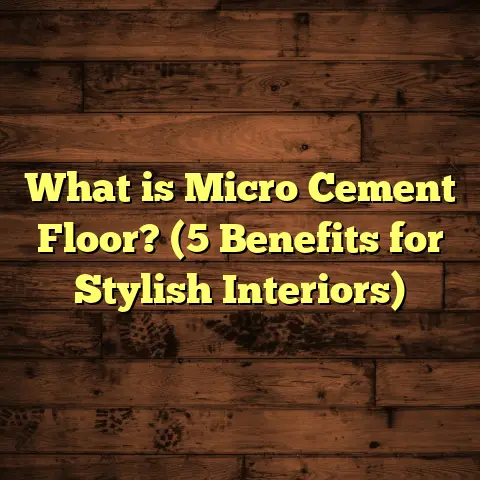What is Bamboo Flooring? (5 Benefits for Eco-Friendly Homes)
The weather has a funny way of making you rethink your home choices. I remember one summer when the humidity was so intense it felt like the air was dripping with moisture. My old wooden floors started to warp and buckle in places. It was frustrating because hardwood was supposed to be a reliable option, right? That’s when I started seriously looking into alternatives — options that could handle changing climates but still gave the warmth and beauty of natural materials. Bamboo flooring stood out immediately, and it’s become my top recommendation for anyone who wants to create a sustainable, stylish, and durable living space.
If you’re curious about bamboo flooring but aren’t sure where to start, let me walk you through what it really is, why it’s a smart choice for eco-friendly homes, and how you can make the most of it in your own space.
What is Bamboo Flooring?
At its core, bamboo flooring is made from bamboo grass, not wood. This grass grows rapidly—much faster than trees—and can be harvested in just 3 to 5 years. This rapid growth rate is why bamboo is often called a “renewable resource.” Unlike hardwood trees that take decades to mature, bamboo can be replenished quickly without damaging the environment.
The flooring planks are made by cutting the bamboo stalks into thin strips, which are then treated, glued together under heat and pressure, and finished to create durable floorboards. There are different styles of bamboo flooring: horizontal, vertical, and strand-woven.
- Horizontal bamboo shows the cross-section of the stalk with distinctive nodes.
- Vertical bamboo displays long, narrow strips aligned vertically.
- Strand-woven bamboo is made by shredding the strips and compressing them into dense planks.
Each type has a unique look and durability level.
I first encountered bamboo flooring during a renovation project for a client focused on sustainability. They wanted floors that would last but also reduce the home’s environmental footprint. After installing strand-woven bamboo, they were thrilled with how well it handled wear and tear from their busy household.
Why Bamboo Flooring?
Quick Growth Means Less Environmental Impact
One of the biggest reasons I love bamboo flooring is how fast bamboo grows compared to hardwood trees. Bamboo can grow up to 3 feet per day in ideal conditions and matures in roughly 3-5 years. In contrast, hardwood trees like oak or maple can take 20-50 years to mature.
This rapid growth means bamboo can be harvested more often without depleting resources. It also absorbs more carbon dioxide and releases more oxygen than many tree species. According to a 2019 World Wildlife Fund report, bamboo absorbs carbon dioxide and releases 35% more oxygen than equivalent tree stands. That’s a huge plus for fighting climate change.
When I switched my own floors to bamboo, I felt good knowing I was supporting a material that replenishes quickly and requires fewer chemicals like fertilizers or pesticides.
Durability That Competes with Hardwood
You might wonder: can bamboo really stand up to daily life? From my experience working on many projects, strand-woven bamboo is one of the hardest natural flooring materials available.
The Janka hardness test measures wood resistance to denting. Strand-woven bamboo scores around 3,000 pounds-force (lbf), compared to red oak’s 1,290 lbf. That means strand-woven bamboo can handle double the pressure before showing dents.
For example, one family I worked with had two kids who loved racing their bikes indoors and a large dog that tracked dirt daily. Their strand-woven bamboo floors stayed beautiful after three years of heavy use without needing repairs or refinishing.
Design Flexibility
Bamboo flooring isn’t limited to one look or color. It comes in various finishes—from natural pale hues to rich caramel tones created by carbonizing (heating) the bamboo.
Strand-woven bamboo offers a texture similar to hardwood with grain patterns that can vary from subtle to bold.
I once helped a client pick bamboo floors for their modern farmhouse. They chose light-colored vertical grain bamboo with a matte finish. It gave the space warmth without feeling overwhelming or too rustic.
Installation Ease
If you’re handy or want to save money on installation costs, bamboo floors are often designed for easy installation. Many come as click-lock planks suitable for floating floor systems—meaning no nails or glue are necessary.
I’ve installed bamboo floors for friends myself using these systems. The process took about half the time compared to traditional hardwood installation.
Affordable Luxury
While hardwood prices have been climbing steadily—especially for exotic species—bamboo offers a more affordable alternative without sacrificing durability or style.
Typical prices range from $3 to $8 per square foot depending on quality and finish, which is generally less than mid- to high-end hardwoods.
Many clients get excellent value from mid-range strand-woven bamboo floors—they pay less upfront but get long-lasting quality.
The 5 Benefits of Bamboo Flooring for Eco-Friendly Homes
Let me break down five key benefits I’ve seen firsthand that make bamboo flooring a great choice if you want an eco-conscious home.
1. Rapid Renewability Means Bamboo Protects Forests
Choosing bamboo helps reduce demand for slow-growing hardwoods like oak or mahogany. Since bamboo matures in just a few years, harvesting it causes less damage to ecosystems.
Global hardwood deforestation rates remain concerning; between 2015 and 2020, the Food and Agriculture Organization reported over 10 million hectares of forest lost annually worldwide.
By switching to rapidly renewable materials like bamboo, homeowners play a role in protecting forests and biodiversity.
2. High Durability Suits Busy Households
If you have kids, pets, or just heavy foot traffic in your home, durability matters. Strand-woven bamboo’s exceptional hardness means it resists scratches and dents better than many hardwoods.
In my projects installing strand-woven floors in rental properties, I’ve noticed tenants dragging furniture or dropping items caused little damage over years.
With proper care (more on that soon), these floors can last 20+ years without refinishing.
3. Lower Carbon Footprint Than Hardwood or Carpet
Bamboo’s rapid growth means it sequesters carbon faster than trees. Additionally, manufacturing processes for bamboo flooring generally emit fewer greenhouse gases compared to hardwood milling or carpet production.
A 2020 lifecycle assessment by the University of California found that strand-woven bamboo flooring had approximately 30-40% lower global warming potential per square meter than oak hardwood flooring.
If reducing carbon emissions is part of your home goals, bamboo makes a measurable difference.
4. Easy Maintenance Saves Time and Money
Bamboo doesn’t require complicated care routines like some exotic hardwoods that need special polishes or oils.
Just sweeping or vacuuming regularly prevents dirt scratches. A damp mop with mild cleaner every few weeks keeps it fresh.
I’ve advised many clients on simple maintenance plans that extend floor life with minimal effort—saving money on costly repairs down the road.
5. Stylish Options Match Any Décor
Bamboo’s natural tones complement everything from rustic cabins to sleek urban flats.
Whether you prefer light blondes or rich browns, horizontal or vertical grains, there’s a look for every taste.
One friend paired carbonized strand-woven bamboo floors with industrial steel accents in her apartment—giving her space warmth and character without clashing styles.
My Personal Journey with Bamboo Flooring
When I first started recommending bamboo floors about ten years ago, I was skeptical about durability claims. Hardwood has been my family’s go-to for generations; it felt like stepping away from tradition.
But after installing strand-woven bamboo in my own home’s living room—an area with constant foot traffic from kids, pets, and guests—I was pleasantly surprised by how resilient it was. Over five years later, the floors show almost no signs of wear despite countless spills, drops, and heavy furniture moves.
What convinced me even more was seeing how quickly the material replenishes in plantations near my hometown during visits. The contrast between slow-growing hardwood forests and fast-growing bamboo groves made me appreciate its sustainability even more deeply.
I now recommend it not just as an alternative but often as my first choice for clients aiming for eco-friendly homes without compromising style or durability.
Bamboo Flooring Installation: What You Should Know
If you’re considering installing bamboo floors yourself or hiring pros, here are some tips based on my hands-on experience:
Assess Your Subfloor Carefully
Your subfloor must be clean, dry, level, and structurally sound before laying bamboo planks. Uneven surfaces can cause gaps or squeaks later.
For concrete subfloors, moisture barriers may be necessary since excess moisture can damage bamboo even though it’s more moisture-resistant than hardwood.
Choose the Right Type for Your Room
- Strand-woven is best for high-traffic areas due to hardness.
- Horizontal or vertical grain works well in bedrooms or living rooms with moderate use.
- Avoid using bamboo in bathrooms unless specifically rated for high moisture areas.
Acclimate Your Flooring
Just like hardwood, bamboo needs time to adjust to your home’s humidity before installation—usually 48–72 hours unopened in the room where it will be installed.
Use Proper Tools
A quality saw designed for laminate or hardwood works well for cutting planks cleanly without splintering edges.
Use spacers during installation to allow for expansion gaps around walls—usually around ½ inch wide—to avoid buckling as materials expand seasonally.
Hiring Professionals vs DIY
While DIY installation saves money if you’re confident with tools and instructions, professional installers bring experience that ensures longer-lasting results and warranty compliance.
In my work as a contractor, I’ve seen poor installation cause issues even with high-quality materials. So weigh your skill level honestly before deciding which route suits your project best.
Caring for Your Bamboo Floors: Tips That Work
Maintaining your bamboo floors well extends their life and keeps them looking great year-round. Here are practical tips I share with every client:
- Sweep or vacuum frequently: Dirt particles act like sandpaper scratching surface finishes.
- Use a damp mop: Avoid soaking floors; excess water harms adhesives and wood fibers.
- Avoid harsh chemicals: Stick to pH-neutral cleaners designed for wood or bamboo.
- Place mats at entrances: Catch dirt before it reaches floors.
- Use protective pads under furniture: Prevent gouges from chair legs or heavy items.
- Refinish when needed: Strand-woven floors can often be sanded and refinished multiple times over decades.
- Control indoor humidity: Keep between 40-60% relative humidity to prevent cupping or cracking due to moisture swings.
In one project I supervised at an office space with bamboo flooring installed five years ago, simple monthly cleaning routines kept floors shiny without any refinishing needed yet despite heavy foot traffic.
Comparing Bamboo Flooring With Other Popular Options
If you’re still deciding on your flooring material, here’s how bamboo stacks up against common alternatives:
| Flooring Type | Cost per sq.ft | Durability (Janka) | Eco-Friendliness | Maintenance | Style Options |
|---|---|---|---|---|---|
| Strand-Woven Bamboo | $4 – $8 | ~3000 lbf | Highly renewable & low emissions | Easy | Wide variety |
| Oak Hardwood | $5 – $12 | ~1290 lbf | Slow growing; higher emissions | Moderate (polish/refinish) | Classic wood grain |
| Laminate | $1 – $5 | Varies (not real wood) | Synthetic materials; less eco | Easy | Many designs |
| Vinyl | $2 – $7 | Moderate | Petroleum-based; less sustainable | Easy | Many colors & patterns |
| Carpet | $2 – $10 | Low | Synthetic; short lifespan | High (cleaning) | Many colors/textures |
Bamboo offers strong durability combined with eco-friendliness at an affordable price point — an advantage over many hardwoods and synthetic options.
Real Case Study: Bamboo Flooring in a Green Home Build
I worked recently with a family building a new home focused entirely on sustainability—from solar panels to energy-efficient windows and low-VOC paints. Their flooring choice was critical since it impacts indoor air quality and environmental impact significantly.
We selected strand-woven bamboo flooring certified by FSC (Forest Stewardship Council) to guarantee responsible sourcing. The installers used low-VOC adhesives and finishes to keep indoor air healthy during construction.
After six months of living there:
- They reported no issues with floor durability despite two young children.
- Energy bills were lower due to better insulation under the flooring.
- Indoor air quality tests showed reduced VOC levels compared to neighboring homes using vinyl floors.
- The family felt proud knowing their floor choice contributed positively to their overall green building goals.
This project reinforced my belief that bamboo flooring isn’t just a trend but a meaningful step toward sustainable living spaces.
Frequently Asked Questions About Bamboo Flooring
I often get asked these questions by clients thinking about switching:
Q: Can bamboo flooring be used in kitchens or bathrooms?
A: Bamboo fares better than hardwood in slightly humid areas but isn’t waterproof like tile or vinyl. Use in kitchens is common if spills are wiped quickly. Avoid bathrooms unless the product is specifically rated for wet areas.
Q: Is carbonized bamboo less durable?
A: Carbonizing darkens the color through heat but reduces hardness slightly compared to natural finishes. Strand-woven carbonized options still remain very tough though.
Q: How long does bamboo flooring last?
A: With proper care, well-installed strand-woven bamboo can last 20+ years before refinishing is needed; horizontal/vertical grain types may need refinishing sooner depending on wear.
Q: Does bamboo flooring scratch easily?
A: It resists scratches better than many hardwoods but still benefits from careful maintenance like using furniture pads and regular cleaning.
Final Thoughts on Bamboo Flooring Choices
Switching your floors is a big decision with long-term impact. From what I’ve seen over years working closely with homeowners and contractors alike:
- Bamboo flooring offers a rare combination of beauty, toughness, affordability, and sustainability.
- Its fast renewability helps protect forests while providing durable surfaces that stand up well in real life.
- Installation is approachable whether you DIY or hire pros.
- Maintenance is straightforward enough for busy households.
- Style options are diverse enough to fit nearly any design vision—whether rustic charm or urban sleekness.
Choosing bamboo means contributing positively to your home environment both aesthetically and ecologically.
If you want help figuring out which type suits your needs or how best to care for your new floors, just ask! I’m always happy to share what I’ve learned from real projects and personal experience.
Have you ever had experiences with bamboo flooring? Or are you debating between options? Let’s chat—I’d love to hear your thoughts!





